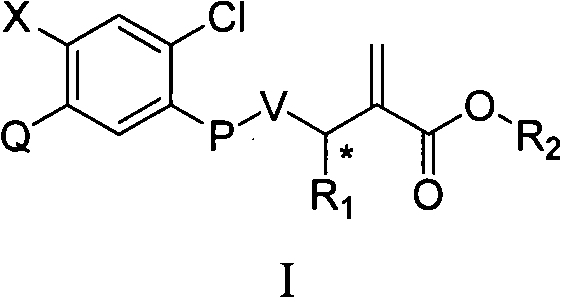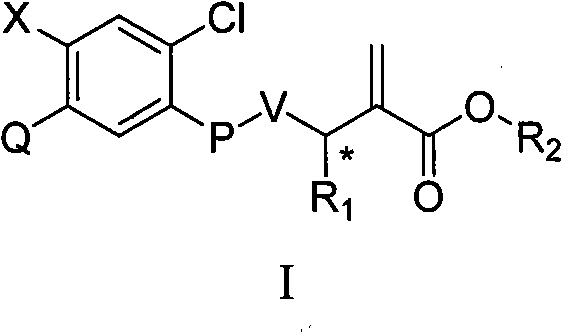2-alkyl acrylate compounds and uses thereof
A technology of alkyl acrylates and compounds, which is applied in the field of 2-alkyl acrylate compounds, and can solve the problems that alkacrylate compounds have not been disclosed.
- Summary
- Abstract
- Description
- Claims
- Application Information
AI Technical Summary
Problems solved by technology
Method used
Image
Examples
Embodiment 1
[0098] Embodiment 1: the synthesis of compound 1
[0099]
[0100] Add successively 2.2 grams of substituted phenols (6.0 millimoles, made with reference to the operation method provided by EP68822), 10 milliliters of N, N-dimethylformamide and 0.24 grams of sodium hydride (6.0 millimoles) in a 100 milliliter reaction flask, 1.0 g (5.0 mmol) of methyl 2-(bromomethyl)acrylate was stirred at room temperature for 1 hour. The reaction solution was poured into 20 ml of water, extracted with 100 ml of ethyl acetate, the organic layer was washed successively with saturated sodium carbonate solution, water, and saturated brine, dried over anhydrous magnesium sulfate, concentrated under reduced pressure, and the residue was purified by column chromatography ( Eluent: ethyl acetate:petroleum ether=1:10), to obtain 0.70 g of white solid compound 1, yield: 36%.
Embodiment 2
[0101] Embodiment 2: the synthesis of compound 12
[0102]
[0103] Add successively 0.62 grams of substituted benzoic acid (2.0 millimoles, prepared with reference to the operation method provided by EP68822), 10 milliliters of dichloromethane and 0.38 grams of oxalyl chloride (3.0 millimoles) and 1 drop of N, N - Dimethylformamide, stirred at room temperature for 1 hour. The reaction solution was concentrated under reduced pressure to obtain 0.67 g of a yellow solid (abbreviated as benzoyl chloride), yield: 99%.
[0104]
[0105] Add 0.36 grams of 2-(1-hydroxyethyl) ethyl acrylate (2.0 mmoles, prepared with reference to the method provided by US3742669), 10 milliliters of dichloromethane and 0.31 grams of triethylamine (3.0 mmol), a solution of 0.67 g (2.0 mmol) of the above benzoyl chloride in dichloromethane (10 ml) was added dropwise, and the mixture was stirred at room temperature for 1 hour after the addition was completed. The reaction solution was poured into ...
Embodiment 3
[0106] Embodiment 3: the synthesis of compound 13
[0107]
[0108] Add 2.40 grams (10.0 mmoles) of 2-chloro-4-fluoro-5-nitrophenol, 20 milliliters of N, N-dimethylformamide, 1.70 grams (12.0 mmoles) of potassium carbonate successively in a 50 ml reaction flask. ) and 2.90 g (10.0 mmol) of ethyl 2-(bromomethyl)acrylate, and stirred at 60° C. for 5 hours. The reaction solution was poured into 20 ml of water, extracted with 100 ml of ethyl acetate, the organic layer was washed successively with saturated sodium carbonate solution, water, and saturated brine, dried over anhydrous magnesium sulfate, concentrated under reduced pressure, and the residue was purified by column chromatography ( Eluent: ethyl acetate:petroleum ether=1:12), to obtain 2.37 g of white solid 2-{2-chloro-4-fluoro-5-nitrophenoxymethyl}ethyl acrylate (nitro for short) , Yield: 78%.
[0109]
[0110] 2.37 g (7.0 mmol) of the above-mentioned nitro substance, 20 ml of acetic acid, and 1.6 g (2.89 mmol) o...
PUM
 Login to View More
Login to View More Abstract
Description
Claims
Application Information
 Login to View More
Login to View More - R&D
- Intellectual Property
- Life Sciences
- Materials
- Tech Scout
- Unparalleled Data Quality
- Higher Quality Content
- 60% Fewer Hallucinations
Browse by: Latest US Patents, China's latest patents, Technical Efficacy Thesaurus, Application Domain, Technology Topic, Popular Technical Reports.
© 2025 PatSnap. All rights reserved.Legal|Privacy policy|Modern Slavery Act Transparency Statement|Sitemap|About US| Contact US: help@patsnap.com



